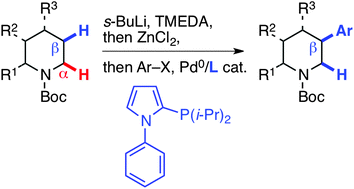Ligand-controlled β-selective C(sp3)–H arylation of N-Boc-piperidines†
Abstract
We report a general

* Corresponding authors
a
Université Claude Bernard Lyon 1, CNRS UMR 5246 – Institut de Chimie et Biochimie Moléculaires et Supramoléculaires, CPE Lyon, 43 Boulevard du 11 Novembre 1918, 69622 Villeurbanne, France
E-mail:
olivier.baudoin@univ-lyon1.fr
b Institut Charles Gerhardt, CNRS UMR 5253, Université Montpellier 2, case courrier 1501, Place Eugène Bataillon, 34095 Montpellier, France
We report a general

 Please wait while we load your content...
Something went wrong. Try again?
Please wait while we load your content...
Something went wrong. Try again?
A. Millet, P. Larini, E. Clot and O. Baudoin, Chem. Sci., 2013, 4, 2241 DOI: 10.1039/C3SC50428J
To request permission to reproduce material from this article, please go to the Copyright Clearance Center request page.
If you are an author contributing to an RSC publication, you do not need to request permission provided correct acknowledgement is given.
If you are the author of this article, you do not need to request permission to reproduce figures and diagrams provided correct acknowledgement is given. If you want to reproduce the whole article in a third-party publication (excluding your thesis/dissertation for which permission is not required) please go to the Copyright Clearance Center request page.
Read more about how to correctly acknowledge RSC content.
 Fetching data from CrossRef.
Fetching data from CrossRef.
This may take some time to load.
Loading related content
